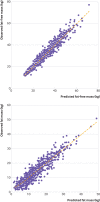Development and validation of a prediction model for fat mass in children and adolescents: meta-analysis using individual participant data
- PMID: 31340931
- PMCID: PMC6650932
- DOI: 10.1136/bmj.l4293
Development and validation of a prediction model for fat mass in children and adolescents: meta-analysis using individual participant data
Abstract
Objectives: To develop and validate a prediction model for fat mass in children aged 4-15 years using routinely available risk factors of height, weight, and demographic information without the need for more complex forms of assessment.
Design: Individual participant data meta-analysis.
Setting: Four population based cross sectional studies and a fifth study for external validation, United Kingdom.
Participants: A pooled derivation dataset (four studies) of 2375 children and an external validation dataset of 176 children with complete data on anthropometric measurements and deuterium dilution assessments of fat mass.
Main outcome measure: Multivariable linear regression analysis, using backwards selection for inclusion of predictor variables and allowing non-linear relations, was used to develop a prediction model for fat-free mass (and subsequently fat mass by subtracting resulting estimates from weight) based on the four studies. Internal validation and then internal-external cross validation were used to examine overfitting and generalisability of the model's predictive performance within the four development studies; external validation followed using the fifth dataset.
Results: Model derivation was based on a multi-ethnic population of 2375 children (47.8% boys, n=1136) aged 4-15 years. The final model containing predictor variables of height, weight, age, sex, and ethnicity had extremely high predictive ability (optimism adjusted R2: 94.8%, 95% confidence interval 94.4% to 95.2%) with excellent calibration of observed and predicted values. The internal validation showed minimal overfitting and good model generalisability, with excellent calibration and predictive performance. External validation in 176 children aged 11-12 years showed promising generalisability of the model (R2: 90.0%, 95% confidence interval 87.2% to 92.8%) with good calibration of observed and predicted fat mass (slope: 1.02, 95% confidence interval 0.97 to 1.07). The mean difference between observed and predicted fat mass was -1.29 kg (95% confidence interval -1.62 to -0.96 kg).
Conclusion: The developed model accurately predicted levels of fat mass in children aged 4-15 years. The prediction model is based on simple anthropometric measures without the need for more complex forms of assessment and could improve the accuracy of assessments for body fatness in children (compared with those provided by body mass index) for effective surveillance, prevention, and management of clinical and public health obesity.
Published by the BMJ Publishing Group Limited. For permission to use (where not already granted under a licence) please go to http://group.bmj.com/group/rights-licensing/permissions.
Conflict of interest statement
Competing interests: All authors have completed the ICMJE uniform disclosure form at www.icmje.org/coi_disclosure.pdf and declare: this research was supported by grants from the British Heart Foundation (PG/15/19/31336 and FS/17/76/33286). Diabetes prevention research at St George’s, University of London, is supported by the National Institute of Health Research (NIHR) Collaboration for Leadership in Applied Health Research and Care South London (NIHR CLAHRC-2013-10022); no financial relationships with any organisations that might have an interest in the submitted work in the previous three years; no other relationships or activities that could appear to have influenced the submitted work.
Figures



References
-
- World Health Organization. Childhood overweight and obesity 2014 www.who.int/dietphysicalactivity/childhood/en/ Accessed August 2016.
-
- Bridges S, Darton R, Evans-Lacko S, et al. Health Survey for England 2014. In: Craig R, Fuller E, Mindell J, eds, 2015.
Publication types
MeSH terms
Grants and funding
LinkOut - more resources
Full Text Sources
Medical
